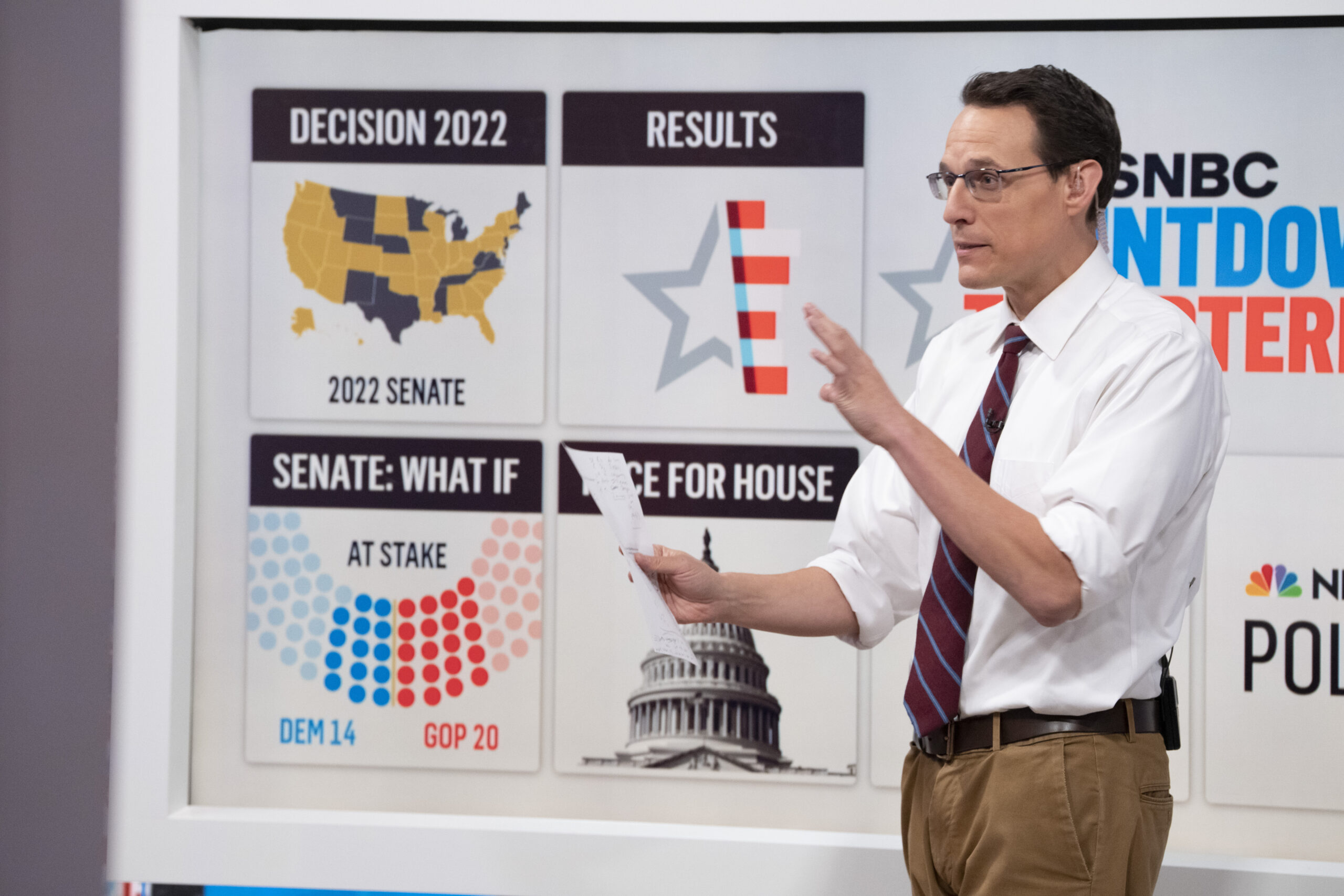MSNBC Elections Maven Steve Kornacki Prepares For Nail-Biting Midterms

Virginia Sherwood/MSNBC
It took days to declare President Joe Biden the winner of the 2020 election, thanks to delays in the counting of the vote in several key states.
Six of those states have competitive Senate races this year, which means we may not know the results of the midterm elections on Tuesday night. It may even take days to know which party will control the House and Senate for the remainder of Biden’s term.
However long it takes, Steve Kornacki is ready. The MSNBC and NBC News national political correspondent is once again manning the “Big Board” this year and plans to cover the results as they come until, and until we have answers.
I spoke to Kornacki on this week’s episode of The Interview about what to expect from these midterm elections, what races he has his eyes on, and how he prepares for his marathon coverage of the results.
For Kornacki, the potentially days-long coverage will involve very little sleep and a lot of analysis from the Big Board, which he has spent months practicing on.
The key to staying up is diet. Over the next few days his consumption will be a mix of coffee, Diet Coke and little food (particularly carbs — they knock you out).
Kornacki doesn’t just bring frenetic energy to MSNBC’s Studio 3A in Rockefeller Center, where the network films its Election Night coverage, but also an exhaustive knowledge of the political history that paved the way for our current political climate.
He dives into that history on a new six-episode podcast, The Revolution With Steve Kornacki, which examines how Newt Gingrich steered Republicans to a House majority in the 1994 midterms for the first time in four decades — by pushing the country towards the partisanship that now rules politics.
Read highlights from our interview below.
On what’s in play Tuesday night
Republicans need to pick up five seats to get the House. History certainly says that’s doable for the opposition party in a midterm. You just look at the way the maps are drawn this year. There’s a couple of pretty obvious pickups I think Republicans are going to get just because they do redistricting every ten years. This is a redistricting year and some of these new lines are favorable to Republicans. You add in Biden’s approval rating, attitude towards the economy, that sort of thing. It’s not impossible, but it would be an upset for the ages if Democrats ever held on to the House. The Senate, at 50-50 right now with Democrats technically in control because Kamala Harris breaks the tie — much different story. I think there’s a lot more suspense around that one. And one of the possible outcomes, in fact, is that there is no answer. And we go to a runoff in Georgia in December and that runoff decides Senate control. That’s not impossible at all.
On the importance of Pennsylvania
In the House, [Republicans] just don’t need much. So even a night that would be overall kind of disappointing to Republicans, that the Democrats could point to and say, hey, we didn’t do that bad, could still absolutely involve Republicans taking the House. It’s that small of a margin. On the Senate side, there’s just a bunch of races here that, if you look at the polling average, they’re within a point or two or less. Pennsylvania, Nevada, Georgia, suddenly at the last minute here, New Hampshire seems to be falling into that category. I think for Democrats, they’ve got to win Pennsylvania. Because Pennsylvania is technically a Republican seat right now. Pat Toomey is retiring. Biden won it. All year, Fetterman has, at least until recently, led in the polls. If Democrats can get Pennsylvania, it means if they blow it in, say, Georgia or Nevada, they can absorb one loss in a seat they already hold, counter it with Pennsylvania, still hold the Senate. So I think Pennsylvania’s the single most important just in terms of the math of Senate control.
On dealing with election denialism
I try to think of a viewer who is puzzled by it in good faith. We have a whole conversation about vote counting procedures and election procedures and how there’s been this massive expansion in the last two decades in different ways people can vote and how the bureaucracy in a lot of states hasn’t caught up with it. And it’s created these situations where you can have these drawn out days-long counts where it swings dramatically. And I think there is a person of good faith who — it’s an undue burden on that person to insist that they understand the ins and outs of, Well, don’t you know, it’s Thursday in Arizona, they’re counting the second wave of late arriving mail ballots. These are always trend Republican by 55 or 60! That’s unreasonable to expect. So I try to think of that viewer. I want to be able to give them the play by play in the moment of what it is that is being counted at that moment and why the numbers are now changing in the way that they’re changing so that it can make some sense to them. If I do my job, there’s only so much I can control, and if others out there are going to make claims or whatever, I can put the numbers, I can put the explanation, I can put the facts in. I try to just operate with that viewer of good faith in mind.
Download the full episode here, and subscribe to The Interview on Apple Podcasts or Spotify.